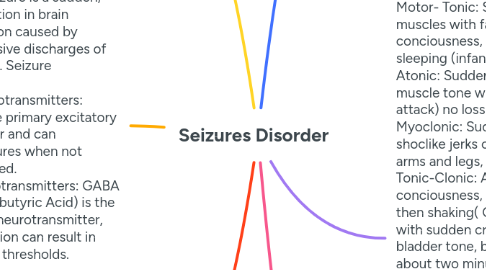
1. Risk factors-Genetics factor- Family history can increase the risk. Age: Seizure occurrences are more common in children and older adults. Head injuries: Trauma to the brain can provoke seizures. Brain conditions: Tumors or strokes increase the risk of seizures. Infections: Conditions like meningitis or encephalitis can lead to seizures. Prenatal injury: Brain damage before birth due to lack of oxygen or nutrition can cause seizures. Developmental disorders: Such as autism or neurofibromatosis.
1.1. First Aid management- Clear area around the patient to avoid harm from object, Let seizure run its course, Put something soft under head of patient Restrain jerkiness NO Keep onlookers away from patient YES Monitor time of seizure YES Stand by the patient’s side whole time of seizure YES Maintain clear respiratory access YES Put something in patient’s mouth NO Roll patient onto their side YES Give antiepileptic medicine immediately Roll patient onto their side YES Give antiepileptic medicine immediately
2. Pathology- a seizure is a sudden, transient disruption in brain electrical function caused by abnormal excessive discharges of cortical neurons. Seizure Mechanisms Excitatory Neurotransmitters: Glutamate is the primary excitatory neurotransmitter and can precipitate seizures when not properly regulated. Inhibitory Neurotransmitters: GABA (Gamma-Aminobutyric Acid) is the chief inhibitory neurotransmitter, and its dysfunction can result in reduced seizure thresholds.
2.1. Etiology-Any disorders that alters the neuronal environemnet may cause seizure activity. Conditions that may cause seizure are metabolic disorders, congenital malformations, genetic predisposition, perinatal injury, postnatal trauma, myoclonic syndromes, infections, brain tumor, vascular diseases, electrolytes imbalances, drug and alcohol abuse or withdrawals.
2.1.1. Primary diagnosis-Health history is the most critical aspect of diagnosing seizure and estabilishing cause and onset. Also, Lab test, urine, EEG, functional Magnetic Resonance Imaging (fMRI), CT Computed Tomography,
3. Test and labs-Test Brain imaging and CSF examination to identify neurologic diseases. EEG to assess the type of seizure and it is focus. fMRI are useful in assessing neural networks involved in epiletic activity. Labs- Blood glucose, serum calcium, Blood urea nitrogen, urine sodium, creatinine clearance measurements to identify any systemic disases that can contribute to seizure triggers. Computed tomography (CT) scan
3.1. Treatment- Anti-seizure medication to suppress the seizure without side effects of drug or drug resistance.Dietary treatments like the Ketogenic and modified Adkins diet. Surgical interventions can improve seizure control and quality of life in people with drug-resistant epilpsy. Vagus nerve stimulation can reduce seizure frequency in person with drug resitant focal seizure.
3.1.1. Anti-Seizure Medications:Topiramate, Vigabatrin, Stiripentol, Zonisamide,Rufinamide,Levetiracetam, Lacosamide, Oxcarbazepine, Diazepam nasal spray.
3.1.2. Anti-Seizure Medications side effects: CNS disturbances, Behavioral changes, Cognitive effects, Weight changes, Psychiatric changes, Gastrointestinal Tract (GIT) disturbance
3.2. Referrals- Neurologist-Dietitian-Pharmacyst- Surgery
4. Seizure Signs and Symptoms:losing consciousness falling to the ground rapid eye movements drooling or foaming at the mouth clenching of the teeth or jaw experiencing incontinence having uncontrollable muscle spasms staring having trouble talking
4.1. Post Seizure Signs and Symptoms: Change in behaviour, motor function, neuro psychological performance. postictal symptoms including depression, anxiety, irritability, hypersalivation, euphoria, hypomania, sleep, coma, lethargy, fatigue, vomiting, anorexia, laughter and sighing 20. The more prevalent postictal symptoms are postictal headache and migraine, postictal psychosis and delirium, postictal Todd’s paresis, postictal aphasia, postictal cognitive deficits (confusion and memory loss) and postictal automatisms.
4.1.1. Avoiding Triggers-hypoglycemia medications withdrawal syndrome sepsis traumatic brain injury fever sleep deprivation
5. Types of seizures-Focal seizure originating in one area of the brain. Motor- Tonic: Stiffening of body muscles with falling, loss of conciousness, can occurs while sleeping (infants and children) Atonic: Sudden, brief loss of muscle tone with falling (drop attack) no loss of conscioness. Myoclonic: Sudden brief of shoclike jerks or twitches of the arms and legs, may drop things. Tonic-Clonic: Abrupt loss of conciousness, body stiffness(tonic), then shaking( Clonic) may begin with sudden cry, sometimes loss of bladder tone, biting tongue, last about two minutes, period of confusion, agitation, fatigue, headache and soreness. Hypermotor: bimanual or bipedal motor activities such as kicking and thrashing, clapping and rubbing of both hands, hugging. Nonmotor: Sensory:numbness, tingling or burning sensation, flashing lights, auditory experiences. Cognitive: Aphasia, hallucination, memory or attention impairment. Autonomic: Blushing, pallor, increased or decreased heart rate, hyper or hypoventilation.
5.1. Generalized Seizure-Seizure originating in both sides of the brain simultaneously; can include tonic, atonic, myoclonic, myoclonic-atonic, clonic-tonic-clonic.
5.1.1. Epileptic spams-Episodes of sudden flexion or extension involving the neck, trunk and extremities. range from sudden head nods to violent body contractions.
5.1.2. Epileptic syndrome: Seizure disorders that display a group of signs an Symptoms.
5.1.3. Neonatal Seizures- Wide variety of abnormal clinical activity, including rhythm.
5.1.4. Juvenille Myoclonic Seizure: Generalized epilepse syndrome wit onset in adolescence. Multifocal myoclonus: seizure often occur early in the morning aggravated by lack of sleep or after excessive alchol intake. Generalized convulsion requiress long-term medication treatment.
5.1.5. Pseudoseizures: Nonepileptic phenoma tha tlook like epileptic seizures, diagnosis often requires video EEG monitoring to capture spells and determine is normal.
5.1.6. Status Epilepiticus- Continuing or recurring seizure activity in which recovery from seizure activity is imcomplete: unrelenting seizure activity can last 30 min or more.
